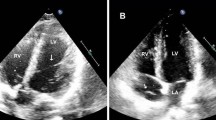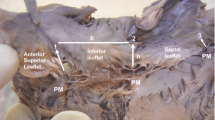Abstract
Left ventricular false tendons (LFTs) have been extensively described and recognized by gross anatomic studies. However, there is very little information available regarding right ventricular false tendons (RFTs). The aim of our study, therefore, was to explore and delineate the morphology, topography and morphometry of the RFTs, and provide a comprehensive picture of their anatomy across a broad range of specimens. We identified 35/100 heart specimens containing right ventricular RFTs and classified them into five types. In Type I (21, 47.7%) the RFTs, was located between the ventricular septum and the anterior papillary muscle; in Type II (11, 22.9%) between ventricular septum and the posterior papillary muscle; in Type III (7, 14.5%) between the anterior leaflet of the tricuspid valve and the right ventricular free wall; in Type IV (5, 10.4%) between the posterior papillary muscle and the ventricular free wall; and lastly, in Type V (4, 8.3%) between the anterior papillary muscle and ventricular free wall. The mean length of the RFTs was 18 ± 7 mm with a mean diameter of 1.4 ± 05 mm. Histologic examination with Masson trichrome and PAS revealed that 20 (41.6%) of the 48 RFTs carried conduction tissue fibers. The presence of conduction tissue fibers within the RFTs was limited to Types I, III, and IV. In Types II and V the RFTs resembled fibrous structures in contrast with Type I, II and IV, which were composed more of muscular fibers, including conduction tissue fibers. RFTs containing conduction tissue fibers were identified, which may implicate them in the appearance of arrhythmias.






Similar content being viewed by others
References
Abdulla A, Frustaci A, Martinez J et al (1990) Echocardiography and pathology of left ventricular false tendons. Chest 98:129–132
Anderson RH, Webb S, Brown NA, Lamers W, Moorman A (2003) Development of the heart: (2) septation of the atriums and ventricles. Heart 89:949–958
Anderson RH, Taylor IM (1972) Development of atrioventricular specialized tissue in human heart. Br Heart J 34:1205–1214
Anderson RH, Ho SY (2003) The morphology of the cardiac conduction system. In: Chawdick DJ, Goode J (eds) Development of the cardiac conduction system. Wiley, New York, pp 6–17
Armiger LC, Urthaler F, James TN (1979) Morphological changes in the right ventricular septomarginal trabecula (false tendon) during maturation and ageing in the dog heart. J Anat 129:805–817
Casta A, Wolf W (1986) Left ventricular bands (false tendons): echocardiographic and angiocardiographic delineation in children. Am Heart J 111:321–324
Clemente CD (ed) (1985) Gray’s anatomy, 30th edn. Lea & Febiger, Philadelphia, pp 631–635
Frater RWM (1994) The right-sided atrioventricular valve. J Heart Valve Dis 3:25–26
Frater RWM (1995) Is right-sided atrioventricular valve trileaflet? J Heart Valve Dis 4:568–570
Frick H (1960) Das Herz der Primaten. In: Hofer H, Schultz AH, Starck D (eds) Primatologia. Vol. I, 4th edn. Basel, New York
Gerlis L, Wright H, Wilson N, Erzengin F, Dickinson DF (1984) Left venticular bands. A normal anatomical feature. Br Heart J 52:641–647
Kervancioglu M, Ozbag D, Kervancioglu P, Hatipoglu ES, Kilinc M, Yilmaz F, Deniz M (2003) Echocardiographic and morphologic examination of left ventricular false tendons in human and animal hearts. Clin Anat 16:389–395
Kobza R, Kurz DJ, Oechslin EN, Pretre R, Zuber M, Vogt P, Jenni R (2004) Aberrant tendinous chords with tethering of the tricuspid leaflets: a congenital anomaly causing severe tricuspid regurgitation. Heart 90:319–323
Kocak A, Govsa F, Aktas EO, Boydak B, Yavuz IC (2004) Structure of the human tricuspid valve leaflets and its chordae tendineae in unexpected death. A forensic autopsy study of 400 cases. Saudi Med J 25:1051–1059
Loukas M, Louis RG Jr, Hullett J, Loiacano M, Skidd P, Wagner T (2005) An anatomical classification of the variations of the inferior phrenic vein. Surg Radiol Anat 27:566–574
Loukas M, Louis RG Jr, Black B, Pham D, Fudalej M, Sharkees M (2007) False tendons: an endoscopic cadaveric approach. Clin Anat 20:163–169
Luetmer P, Edwards W, Seward J, Tajik AJ (1986) Incidence and distribution of left ventricular false tendons: an autopsy study of 483 normal human hearts. J Am Coll Cardiol 8:179–183
McElhinney DB, Silverman NH, Brook MM, Hanley FL, Stanger P (1999) Asymmetrically short tendinous cords causing congenital tricuspid regurgitation: improved understanding of tricuspid valvar dysplasia in the era of color flow echocardiography. Cardiol Young 9:300–304
Moore KL, Dalley AF II (eds) (2006) Clinically oriented anatomy, 5th Edn. Lippincott Williams & Wilkins, Baltimore, pp 147–156
Moorman AFM, Christoffels VM (2003) Development of the cardiac conduction system: a matter of chamber development. In: Chawdick DJ, Goode J (eds) Development of the cardiac conduction system. Wiley, New York, pp 25–34
Moorman AFM, Christoffels VM (2003) Cardiac chamber formation: development, genes, and evolution. Physiol Rev 83:1223–1267
Moreno R, Zamorano J, Ortega A, Villate A, Almeria C, Herrera D, Rodrigo JL, Morales R, Sanchez-Harguindey L (2003) Tricuspid valve chordae rupture following pacemaker electrode replacement. Int J Cardiol 87:291–292
Mukai S, Fuseno H, Nakamura M, Yoshikawa J, Shomura T (1991) Dilated cardiomyopathy complicated by a pedunculated and mobile left ventricular thrombus on a ruptured false tendon. Chest 99:1042–1043
Nigri GR, Di Dio LJ, Baptista CA (2001) Papillary muscles and tendinous cords of the right ventricle of the human heart: morphological characteristics. Surg Radiol Anat 23:45–49
Nishimura T, Kondo M, Umadome H, Shimono Y (1981) Echocardiographic features of false tendons in the left ventricle. Am J Cardiol 48:177–183
Perry LW, Ruckman RN, Shapiro SR, Kuehl KS, Galioto FM, Ruckman RN, Shapiro SR (1983) Left ventricular false tendons in children: prevalence as detected by 2 dimensional echocardiography and clinical significance. Am J Cardiol 52:1264–1266
Roberts W (1969) Anomalous left ventricular band: an unemphasized cause of a precordial murmur. Am J Cardiol 23:735–738
Rosenquist GC, Sweeney LJ (1975) Normal variations in tricuspid valve attachments to the membranous ventricular septum: a clue to the etiology of left ventricle-to-right atrial communication. Am Heart J 89:186–188
Ryssing E, Egeblad H, Berning J (1984) False tendons in the left ventricular outflow tract. Clinical and echocardiograhpic manifestations. Dan Med Bull 31:59–62
Sethuraman K, Sriram R, Balachandar J (1984) Left ventricular false tendons: echocardiographic incidence in India and clinical importance. Int J Cardiol 6:385–387
Skwarek M, Hreczecha J, Grzybiak M, Kosinski A (2005) Remarks on the morphology of the papillary muscles of the right ventricle. Folia Morphol 64:176–182
Skwarek M, Hreczecha J, Dudziak M Grzybiak M (2006) The morphology of the right atrioventricular valve in the adult human heart. Folia Morphol 65:200–208
Standring S (ed) (2005) Gray’s anatomy, 39th edn. Elsevier, Edinburgh, pp 1001–1008
Suwa M, Hirota Y, Nagao H, Kino M, Kawamura K (1984) Incidence of the coexistence of left ventricular false tendons and premature ventricular contractions in apparently healthy subjects. Circulation 70:793–798
Winrow D, Beckmann CF, Lacomis JM, Dedrick CG (1996) Entanglement of a pigtail catheter by the chordae tendineae of the tricuspid valve during pulmonary angiography. Cardiovasc Intervent Radiol 19:275–277
Author information
Authors and Affiliations
Corresponding author
Rights and permissions
About this article
Cite this article
Loukas, M., Wartmann, C.T., Tubbs, R.S. et al. Right ventricular false tendons, a cadaveric approach. Surg Radiol Anat 30, 317–322 (2008). https://doi.org/10.1007/s00276-008-0326-5
Received:
Accepted:
Published:
Issue Date:
DOI: https://doi.org/10.1007/s00276-008-0326-5




